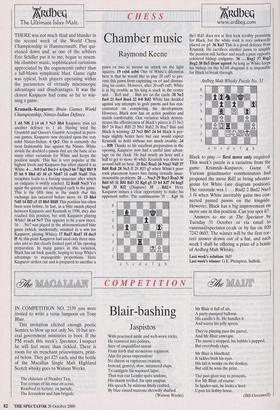Rdbeq The Ultimate Islay Malt.
CHESS
Rdbeq
www.ardbes.corn
Chamber music
Raymond Keene
THERE was not much thud and blunder in the second week of the World Chess Championship in Hammersmith. Play qui- etened down and, as one of the arbiters Eric Schiller put it to me, began to resem- ble chamber music, sophisticated variations appreciated by the cognoscenti rather than a full-blown symphonic blast. Game eight was typical, both players operating within the parameters of virtually miscroscopic advantages and disadvantages. It was the closest Kasparov had come so far to win- ning a game.
Kramnik–Kasparov: Brain Games World Championship; Nimzo-Indian Defence 1 d4 Nf6 2 c4 e6 3 Nc3 Bb4 Kasparov tries yet another defence to 1 d4. Having tried the Grunfeld and Queen's Gambit Accepted in previ- ous games, Kasparov now decided upon the very solid Nimzo-lndian. 4 Qc2 This is currently the most fashionable line against the Nimzo. White avoids the doubled c-pawns that are the bane of so many other variations for White and keeps the position simple. This line is very popular at the highest levels and Kasparov has often played it as White. 4 ... 0-0 5 a3 Exc3+ 6 Qxc3 66 7 Bg5 B67 8 f3 h6 9 Bh4 d5 10 e3 Nbd7 11 cxd5 NxdS This recapture leads to a forcing sequence after which an endgame is swiftly reached. 12 BxdS Nxc3 Yet again the queens are exchanged early in the game. This is the fifth time in the match that this exchange has occurred before move 16. 13 Bh4 Nd5 14 Bf2 c515 Bb5 Rfd8 This position has often been seen before. In fact, in a blitz match played between Kasparov and Kramnik in 1998, they also reached this position, but with Kasparov playing White! 16 e4 Nc7 This appears to be a new move. 16 ... Ne7 was played in the aforementioned blitz game (which, incidentally, resulted in a win for Kasparov, playing White). 17 Bxd7 Rxd7 18 dicc5 f5 At this point Kasparov had used only three min- utes and so this clearly formed part of his opening preparation. In many games in this variation, Black has sat back quietly, hoping to keep White's advantage to manageable proportions. Here Kasparov strikes out and is prepared to sacrifice a pawn or two to mount an attack on the light squares. 19 cxb6 axb6 One of White's dilemmas here is that he would like to play 20 exf5 to pre- vent this pawn from capturing on e4 and disman- tling his centre. However, after 20 exf5 exf5, White is in big trouble as his king is stuck in the centre and ... Re8 and ... Ba6 are on the cards. 20 Net fxe4 21 fxe4 Bxe4 22 0-0 Rd2 White has decided against any attempts to grab pawns and has con- centrated on completing his development. However, Black now has an active position and stands comfortably. One variation which demon- strates the effectiveness of Black's pieces is 23 Nc3 Bb7 24 Racl Rf8 25 Nbl Rxb2 26 Rxc7 Ba6 and Black is winning. 23 Nc3 Bb7 24 b4 Black is per- haps slightly better here but one would expect Kramnik to hold without too much trouble. 24 ... R18 Thanks to his excellent preparation in the opening, Kasparov now had a useful time advan- tage on the clock. He had nearly an hour and a half to get to move 40 while Kramnik was down to around half an hour. 25 Rat Rxa2 26 Nxa2 Nd5 27 Bd4 Ra8 28 Nc3 If 28 Rf3 g5 when White's poor rook placement leaves him facing virtually insur- mountable problems. 28 ... Nxc3 29 Bxc3 Rxa3 30 Bd4 b5 31 Rf4 Rd3 32 Rg4 g5 33 h4 K1'7 34 Ing5 hxg5 35 Kf2 (Diagram) 35 ... Rd2+ Here Kasparov misses a clear opportunity to make his opponent suffer. The continuation 35 ... Kg6 36 Be3 Rd5 does not at first look terribly promising for Black, but the white rook is very awkwardly placed on g4. 36 Ke3 This is a good defence from Kramnik. He sacrifices another pawn to simplify the position still further and reach a pure opposite coloured bishop endgame. 36 ... Rxg2 37 Rxg2 Bxg2 38 Bey Draw agreed As long as White keeps his bishop on the h2-b8 diagonal it is impossible for Black to break through.
Ardbeg Malt Whisky Puzzle No. 51 Black to play — first move only required. This week's puzzle is a variation from the game Krarnnik–Kasparov, Game 9. Various grandmaster commentators had proposed the move Rd2 as being advanta- geous for White (see diagram position). The rationale was 1 . Rxd2 2 Bxd2 NxeS 3 f4 when White inevitably gains two con- nected passed pawns on the kingside. However, Black has a big improvement on move one in this position. Can you spot it?
Answers to me at The Spectator by Tuesday 31 October or via email to vanessa@spectator.co.uk or by fax on 020 7242 0603. The winner will be the first cor- rect answer drawn out of a hat, and each week I shall be offering a prize of a bottle of Ardbeg Malt Whisky.
Last week's solution: Bd5
Last week's winner: G.E. Plumpton, Suffolk.


























































































 Previous page
Previous page